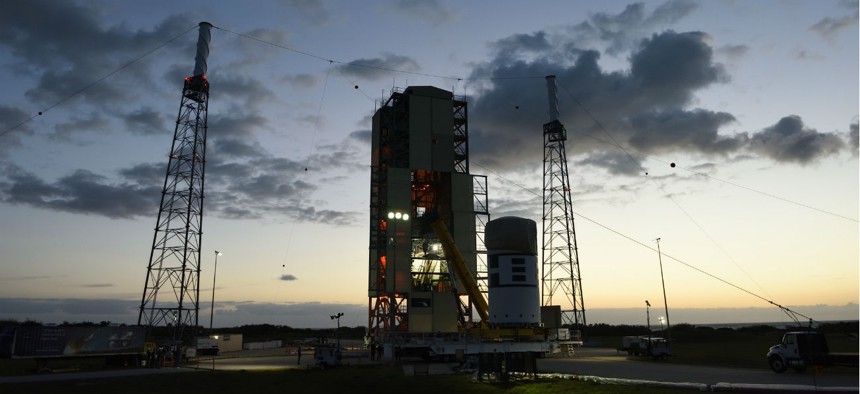
The Abort Test Booster, the rocket that will propel Orion's launch abort system and crew module, in April 2019. NASA photo
NASA Managers and Contractors Significantly Lowballed Space Mission Costs, Watchdog Found
Despite cost overruns and schedule delays, the space agency awarded Boeing and Lockheed Martin $200 million in performance awards, GAO noted.
As NASA prepares to celebrate next month’s 50th anniversary of putting the first man on the moon, a watchdog has thrown some cold water on the space agency’s ambitious plans for future human exploration beyond the Earth’s orbit.
The Government Accountability Office, in a congressionally mandated report released on Wednesday, found significant cost underestimates and schedule delays in three related programs: the Space Launch System vehicle to send people and cargo beyond low-Earth orbit; the Orion spacecraft; and the Exploration Ground Systems that supports those two programs with the necessary systems and infrastructure.
The report to leaders of the House and Senate appropriations panels said continued production and testing challenges put NASA’s Exploration Systems Development organization at risk of missing the launch readiness date of June 2020 for the first of the related missions targeting the moon and, eventually, Mars.
Previous GAO audits had found that “NASA has made programmatic decisions—including establishing low cost and schedule reserves, managing to aggressive schedules, and not following best practices for earned value management—that have compounded technical challenges that are expected for inherently complex and difficult large-scale acquisitions,” the new report said. The agency also had not been following “best practices for establishing cost and schedule baselines for these programs nor update cost and schedule analyses to reflect new risks.”
The result: “NASA overpromised what it could deliver from a cost and schedule perspective,” the auditors wrote, assigning responsibility to both the agency and contractors Boeing and Lockheed Martin.
Back in November 2018, within one year of announcing a delay of up to 19 months for the three programs, “NASA senior leaders acknowledged the revised date of June 2020 is unlikely,” GAO said. “Any issues uncovered during planned integration and testing may push the launch date as late as June 2021. Moreover, while NASA acknowledges about $1 billion in cost growth for the Space Launch System program, GAO estimated the cost growth in excess of $1.8 billion.
NASA “understated” the growth because it shifted some of that project’s “scope to future missions, but did not accordingly reduce the program’s cost baseline,” GAO found.
What’s more, NASA's updated cost estimate for the Orion program reflecting 5.6 percent cost growth “is not complete, however, as it assumes a launch date that is 7 months earlier than Orion's baseline launch date.” If the launch is delayed, costs will rise, GAO said. “Updating baselines to reflect current mission scope and providing complete cost estimates would provide NASA management and Congress with a more transparent assessment of where NASA is having difficulty controlling costs.”
Contractually, from 2014 through 2018, NASA awarded the large companies some $200 million in performance fees on both the tardy and over-budget Space Launch System and Orion projects. “Ongoing contract renegotiations with Boeing for the SLS and Lockheed Martin for the Orion program provide NASA an opportunity to reevaluate its strategy to incentivize contractors to obtain better outcomes,” auditors said after interviews and reviews of program costs, scheduling and contractor data, from March 2018 to this June.
The Federal Acquisition Regulation and NASA contracting guidance indicate that “award fee is appropriate when the work to be performed is such that it is neither feasible nor effective to devise predetermined objective incentive targets applicable to cost, schedule, and technical performance,” GAO noted. However, now that the Space Launch System and Orion programs “are further into the acquisition life cycle, the programs are at the point in development wherein it may be possible to determine more objective targets for cost, schedule, and technical performance, especially for the first mission.”
Because of the cost hikes and delays, GAO noted, NASA is already planning to renegotiate the Boeing contract for the Space Launch System and is revamping the contract with Lockheed for the Orion project.
GAO made four recommendations for updating cost estimates to reflect schedule slippage, and for reevaluating “their strategy for incentivizing contractors.”
NASA agreed with three, but William Gerstenmaier, assistant administrator for human exploration and operations, denied any lack of transparency. Commenting on a draft, he said GAO hadn’t adequately acknowledged that NASA operates in a “dynamic environment, building a multi-decadal program with multiple spacecraft and launch vehicle configurations.”
The space agency is aware, Gerstenmaier stressed, that short-term investments pay off in the long term, stating that the team is still within the timeframe for completion of the projects by April 2023. “NASA’s goal for returning humans to cislunar space remains on track,” he said.
The current fear of delays and cost overrun echoes much of the drama that unfolded during the 1960s as NASA prepared that multi-year program for the historic first moon landing.







